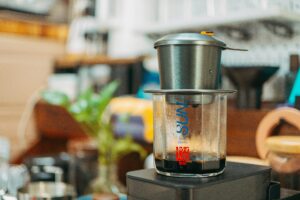Cappuccinos – the quintessential Italian coffee drink that combines espresso’s bold kick with the creamy comfort of steamed milk. But have you ever gazed at a frothy cappuccino and wondered, “Just how much coffee is actually hiding in there?” Fear not, coffee enthusiast! We’re here to delve into the world of cappuccino proportions, brewing techniques, and the magic that transforms a simple espresso shot into a delightful layered masterpiece.
Beyond the Cup: Understanding the Cappuccino’s Anatomy
Imagine a cappuccino as a three-part symphony. The base is a shot of espresso, a concentrated coffee brew bursting with flavor and caffeine. The middle layer is a generous portion of steamed milk, adding a velvety texture and softening the espresso’s intensity. Finally, the crown is a delicate layer of frothed milk, light and airy, providing a delightful textural contrast and visual appeal.
The Golden Ratio: A Recipe for Balance
While variations exist, a classic cappuccino follows a widely accepted 1:1:1 ratio. This translates to:
- 1 part espresso: This is typically a single shot, around 30 milliliters (1 ounce) of strong coffee.
- 1 part steamed milk: Aim for around 60 milliliters (2 ounces) of well-steamed milk, creating that smooth and creamy texture.
- 1 part milk foam: The final layer is a frothy delight, typically around 1-2 centimeters (0.4-0.8 inches) thick.
Tailoring Your Cappuccino Experience
The beauty of coffee is its adaptability. The 1:1:1 ratio provides a foundation, but feel free to customize it to your taste preferences. Here are some factors to consider:
- Strength Preference: Do you crave a bold and intense coffee experience, or a more balanced and mellow drink? Adjust the espresso quantity accordingly.
- Milk Matters: Whole milk adds richness and creaminess, while skim milk offers a lighter option. Consider the fat content of your chosen milk and how it might affect the texture and taste.
- Frothy Finesse: The milk foam plays a key role in both texture and presentation. Experiment with different steaming techniques to achieve your desired level of frothiness.
Smart Electric Kettle Temperature Control

- Smart App & Voice Control
- To-the-degree Temp Control
- Rapid Boil & Keep Warm
From Espresso Machine to Frothy Perfection
Brewing a cappuccino requires some special tools and techniques. Here’s a simplified breakdown for home baristas:
- Pull your espresso shot: Use an espresso machine to extract a concentrated shot of coffee.
- Steam the milk: Heat and froth your chosen milk using a steam wand attachment on your espresso machine. Aim for silky smooth milk with tiny microfoam bubbles.
- Pour the espresso: Carefully pour the extracted espresso shot into a preheated cappuccino cup.
- Milk Magic: Hold back the froth using a spoon and gently pour the steamed milk into the cup, creating a distinct layer below the espresso.
- Frothy Finish: Top it all off with a dollop of the frothed milk, creating a beautiful and inviting cappuccino.
Brewing Hacks for Cappuccino Bliss
- Temperature is Key: For optimal extraction, aim for espresso around 190-195°F (87-90°C) and steamed milk around 140-150°F (60-65°C).
- Freshness is Essential: Use freshly roasted coffee beans for the most vibrant flavor and aroma in your espresso shot.
- Practice Makes Perfect: Mastering the art of milk steaming takes time and practice. Don’t get discouraged – keep experimenting to achieve that perfect microfoam texture.
Brewing a Cappuccino at Home (Without Fancy Equipment)
Don’t have a fancy espresso machine? Don’t despair! Here are some alternative methods to get your cappuccino fix:
- Moka Pot: This stovetop coffee maker brews a strong, concentrated coffee that can be used as a base for a faux-cappuccino.
- Aeropress: This versatile brewer can create a concentrated coffee extract that works surprisingly well for a homemade cappuccino.
- French Press Coffee with Milk Frother: Use a strong French press brew as the coffee base and a handheld milk frother to create a frothy topping.
Exploring the World of Cappuccinos
The classic cappuccino is just the tip of the iceberg. Here are some fascinating cappuccino variations to explore:
- Latte: Similar to a cappuccino, but with a larger milk proportion, resulting in a lighter and less intense coffee drink.
- Cortado: The opposite of a latte, featuring a smaller milk portion than a cappuccino, creating a stronger coffee experience.
- Iced Cappuccino: A refreshing summer twist, featuring chilled espresso, cold milk, and a dollop of frothed milk on top.
- Cappuccino with Flavored Syrups: Add a touch of vanilla, caramel, or hazelnut syrup to your cappuccino for a personalized flavor adventure.
A Celebration of Coffee Artistry
Cappuccinos are more than just a caffeinated beverage; they’re a delightful combination of coffee craftsmanship and artistic expression. With a little practice and exploration, you can unlock the secrets of brewing delicious cappuccinos at home. Remember, there’s no single “correct” way to enjoy a cappuccino. Experiment with ratios, techniques, and variations to discover your perfect cup – a symphony of coffee, milk, and froth that tantalizes your taste buds and awakens your senses. So, grab your favorite mug, fire up your espresso machine (or improvise with alternative brewing methods), and embark on your cappuccino journey! With a splash of creativity and a dash of practice, you’ll be whipping up barista-worthy cappuccinos in no time, ready to savor the frothy perfection in every delicious sip.
Cappuccino Calories Demystified
Curious about the calorie content of your cappuccino? It depends on the ingredients and size. A classic cappuccino made with whole milk and following a 1:1:1 ratio can range from 100-150 calories per serving. Opting for skim milk or a smaller serving size can reduce the calorie count.
Now go forth, brew boldly, and enjoy the delightful world of cappuccinos!






